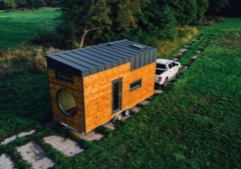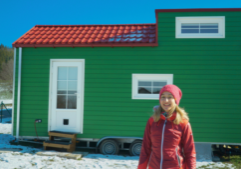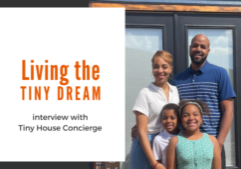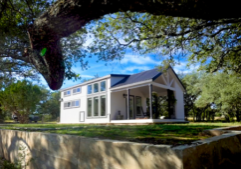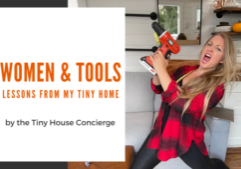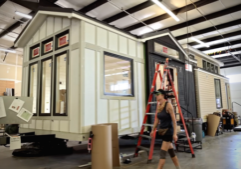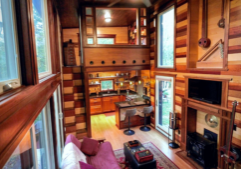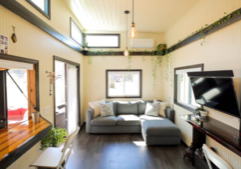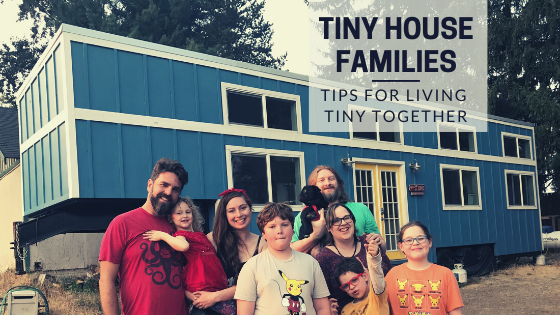
5 Tips to Sharing Your Tiny House with Your Family
Do you consider tiny houses to be purely an individual or couple purchase? Many families prove that you CAN share a tiny house with kids! Here some food for thought & tips to show you how.
Many of us grew up with the fantasy that the goal of life is to study hard, go to college, get a job in your field, save up, and buy a big ol' house with a yard and white picket fence.
This mentality was prevalent among the baby boomer generation. For too many of us, owning a traditional house seems more like a dream than a realistic goal. However, a shift in thinking has fueled the tiny house movement—maybe success isn't about material wealth and maybe living simply can be more rewarding, too.
But are tiny homes practical for families?
Read ahead to learn about how to share a tiny house with kids.
Couple builds tiny home to evolve as their family grows:
Origin of the American Dream
So, just where did the whole thing about the big house, perfect lawn, and white picket fence come from?
James Truslow Adams made the first known mention of the American dream. He believed in a "dream of a land in which life should be better and richer and fuller for every man, with opportunity for each according to his ability or achievement."
The belief was that, in the United States, it didn't matter when you came from or what social status you held. Anyone had the freedom to work hard and make something of themselves.
Keeping Up with the Joneses
Over time, American culture and consumerism morphed this concept into a very limiting view of success. This got translated into a widespread belief that you "making it" meant owning a McMansion with a perfect lawn. And throw in, at least one SUV to take you to and from Starbucks.
It's a vision that is unachievable by many but a misguided marketing concept that makes people feel lacking.
The underlying idea was that "happiness" comes with the accumulation of more and more things, not necessarily from the quality of our relationships.
But a big problem with the constant urge for more is the lack of appreciation for what you do have. It also pulls you further away from what matters most in life.
Enter the rapidly growing trend in the world of tiny houses. The movement embraces simplicity to achieve a higher quality of life. It involves redefining what home and success mean to you.
Quality over Quantity
The idea of going smaller has been around for years.
However, it was uncommon to see families intentionally looking for smaller houses.
Generally, some people thought they were better suited to one or two residents who practice asceticism in every facet of their lives. But the reality is tiny home living comes in my shapes and styles, customized for its occupants' needs.
Families are beginning to see that they, too, can make it work for their needs.
For some tiny house families, it's about slowing down to prioritize togetherness.
While for others, it's about teaching your children values of communication, environmentalism, and that living within your means can be fulfilling.
Tiny House, Big Family: Four Tips for Beginners
There is no one size fits all for small space living. Remember, the idea is that your tiny home should be tailored specifically for its occupant(s) needs.
The good news is you don't have to choose between having a family and your love for independence and sustainability.
A family's needs can be comfortably met in a tiny house. It just takes a little extra creativity and planning. Importantly, we suggest discussing each person's needs, desires, and feelings as a family and one-on-one.
Here are four tips for getting the tiny transition process started:
-
Take Time to Find a Good Price
Having a family takes a lot of dedication, love, and of course, money.
Paying rent for something you'll never own is tough. Additionally, traditional homes can be way too expensive for young families.
Fortunately, tiny houses on wheels offer a sweet spot between homeownership and affordability (as compared to market-rate options).
Some houses can go for as cheap as about $35,000, but typically for smaller sizes not always suited for families. The average price for tiny homes with at least two sleeping areas, when its all said and done, might be around $60,000-75,000.
That is still a lot better than what you would be expected to cough up for McMansion. Just remember the more custom the build, the higher the price. Shop around for multiple quotes from a variety of builders to find the best price.
Also, search Tiny House Listings, Tiny Home Marketplace, and tiny house Facebook groups for reasonable prices on preowned homes.
While DIY building is the best way to save (as much as half off), you'll need at least several months to 1.5 years, especially if you don't have experience. While it could be an opportunity for hands-on learning for the whole family, it could also cause significant stress.
-
Get Rid of Clutter
Downsizing is essential for transitioning into a tiny home. This process will take time; think months. Start slow. Ask everyone to make keep, maybe, and get rid of piles.
Another helpful tool is identifying storage space opportunities in your future tiny house. Knowing how much room you'll have, we'll help you determine how much each family member can keep.
You can always add or better optimize available storage. Shelves, cabinets, and drawers are your friends—easy to use and help keep a tidy, decluttered look/feel.
Don't forget about efficiently-designed closets, like built into stairs, and multifunctional furniture, like a couch with storage compartments. They can help keep everything organized and maximize your free space.
Of course, there is no way around that fact, but you should still try to avoid accumulating unnecessary stuff.
When you have kids, people will always feel the need to give you countless plastic toys and trinkets as gifts. They mean well, but if you're serious about this lifestyle, you might want to have a serious conversation with your extended family about gift-giving best practices.
-
Maximize Sustainability
Just by living tiny, your family is reducing your overall carbon footprint. Further proving, you can have kids and keep your dedication to maintaining a sustainable lifestyle. Though, this often means extra effort by the whole family.
What can feel like a sacrifice is an opportunity to teach your kids to be more conscientious.
For instance, a composting toilet requires emptying as much as once a week, for regular use by a family. It is an extra chore but is saving 1.5 gallons of precious water with each use.
This can everyone learn how to be more aware of resource use, cementing long-term positive behaviors like turning off the water while brushing teeth, etc. Your family can take these lessons with them into any future home, no matter the size.
-
Cleanliness Is Next to Godliness
Smaller living spaces seem to get messier faster than big homes. The upside is doesn't take long to clean up.
This doesn't mean that big houses are cleaner or better organized. But it is easier to hide your stuff or disperse messiness when you have more space.
Maintaining a clean and organized tiny home is necessary to keep your sanity.
Trust me, don't underestimate the value of having "a place for everything and everything in its place."
Every family member must help maintain order by cleaning up after themselves. If done daily, it only takes 10-15 minutes to achieve tidy space.
-
Pass on the Wisdom
As parents, we are charged with the task of teaching the next generation how to do a better job of living in harmony with the Earth. Additionally, how to live their values, not what advertising messages or out-dated cultural ideas on the meaning of home and success.
Sharing a small space with kids can be challenging. View this as an opportunity. Teach your kids what it takes to keep a tidy house, compromise, and spread the love for the tiny house community.
No matter how long you live, two to ten years, the gratitude your family will learn for each other, for what they do have, and for things like water usage, is completely worth it—valuable life lessons.
Also, it might help you get out of debt or save up for a larger home.
Never Give Up Your Dreams
Anyone who tells you can't live in a tiny house with kids is wrong.
There are plenty of ways to make it work. Though this will look different for each family, and that's ok.
A central tenant of the tiny house movement is to live life on your own terms, centered around your priorities and lifestyle goals, not anyone else's ideas of how to do things.
Sure, it's not going to be easy, because parenting never is. Remember the reasons why you started. Stay true to all your personal and family goals.
Keep scrolling our blog for more tips and advice!

